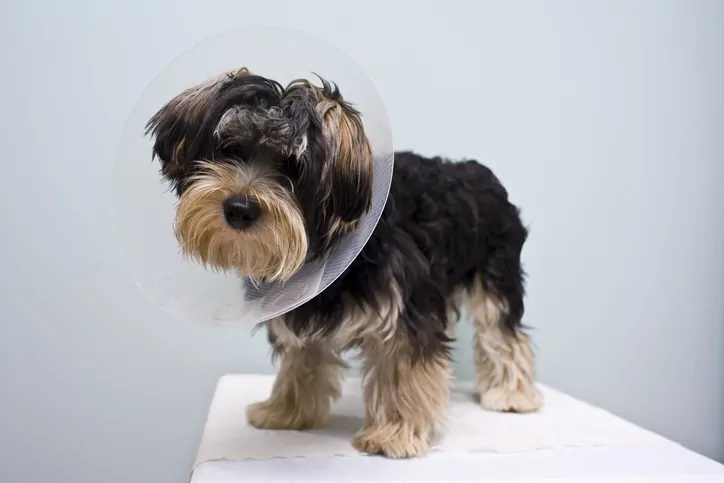When you spay or neuter your pet, you are doing your part to reduce the overpopulation of cats and dogs in your neighborhood, with added benefits such as reduced incidence of some pet diseases, improved pet behaviors, and a longer, happier life for your pet.
You can determine the best age to spay or neuter your pet by consulting with your veterinarian, who will take your pet's species, breed, size, and lifestyle into consideration before making a recommendation.
Your pet will be placed under anesthesia, the spay/neuter procedure will be performed, and the incision will be closed with stitches, except in male cats who heal without stitches.
Your pet will be groggy post-surgery and should be confined and observed with water and half portions for a day or two. Their wound should be kept dry and your pet's activity should be restricted for 10 to 14 days post-surgery.
The primary goal of spay and neuter surgery is to reduce the overpopulation of domesticated animals. Unaltered felines can give birth to over 100 kittens in their lifetime, while female dogs can have around 70 puppies in theirs. This puts a tremendous strain on neighborhood shelters and results in large numbers of unwanted pets that have to be euthanized.

Beyond the impact that spaying and neutering have on overpopulation, spaying female pets and neutering male pets benefit their health and quality of life as well as resolve some behavior issues. Specific benefits include:
The cost of spay and neuter surgery may include vaccinations if your pet is not up-to-date, and costs vary based on your location. However, those costs are trivial compared to the cost of medical care for many litters and the price tag for treating the serious health conditions that altering your pet prevents. Some communities even offer discount spay and neuter programs to reduce the number of stray pets in their neighborhoods.
Concern about spay and neuter procedures revolves around the health risks posed by sterilizing your pet too early. Research has shown a correlation between early sterilization and a higher likelihood of some cancers, joint problems, and urinary incontinence in cats and dogs.
Early or pediatric sterilization occurs between 6 to 8 weeks of age in most breeds of cats and dogs. Standard spay and neuter procedures are performed at 5 to 9 months old. Some pet owners opt to wait until their pet goes into first heat at between 5 to 12 months of age. However, most cats are not mature until 18 months old and large breed dogs usually don't reach full maturity until 12 to 18 months old.
If you're confused about the right age to have your pet spayed or neutered, your veterinarian can provide specific recommendations based on your pet's species, size, breed, and lifestyle that also take into account your individual concerns. There are products that basically function as a chastity belt for your female pet when they are outdoors and protect them from unwanted pregnancy until you decide the time is right to have them sterilized.
Spay and neuter procedures are very safe and simple surgeries. A shot of sedatives and painkillers is administered to your pet before general anesthesia. Dogs are intubated with a breathing tube in their throat during surgery. Whereas, cats are fitted with an oxygen mask because their sterilization procedures are performed very quickly. While your pet is sedated, a machine will monitor their heart rate and oxygen level. Female dogs and cats are kept warm with a heating pad during surgery.
In spay surgery, an incision is made into the abdomen of your female pet immediately below the belly button. Through this incision, the whole reproductive tract, including the uterus and both ovaries, is removed. The incision is then closed with two layers of stitches placed beneath your pet's skin, which will eventually fall out or be absorbed by the body. Skin staples, skin glue, or stitches are some of the methods used to close your pet's skin. Spay surgery takes 15 to 20 minutes for cats and 20 to 90 minutes for dogs.
Male dogs are neutered through an incision that is made in their skin at the base of the penis close to the scrotum. This incision is used to remove both testicles. Stitches are then placed under the skin to close the wound; these stitches will eventually fall out and be absorbed by the body. Skin staples, skin glue, or stitches are also used to close the skin after your pet is neutered. Neuter surgery in dogs takes anywhere from 5 to 20 minutes.
For male cats, the testicles are removed through an incision made in the scrotum skin. The incision is not sealed with stitches, however, it will eventually close by itself. Male cats can be neutered in as little as 2 minutes.
Spay surgery is more invasive than neutering and has a longer recovery time. That being said, aftercare instructions for both spay and neuter procedures are pretty much the same. Some things you can do to help your pet recover include:
If you have any concerns about your pet's recovery, reach out to your veterinarian for further advice.
Phone: (855) 461-8259
Email: [email protected]